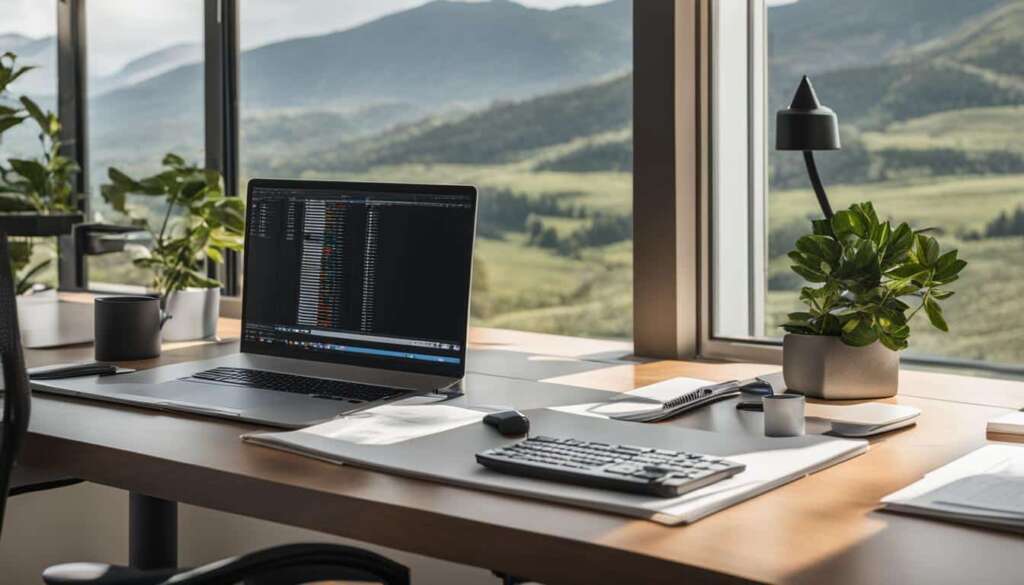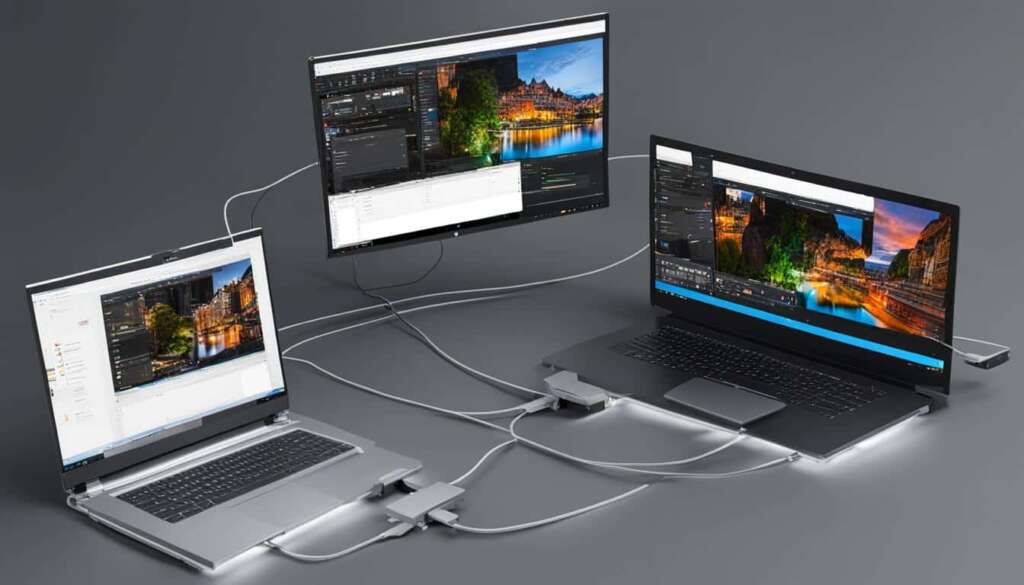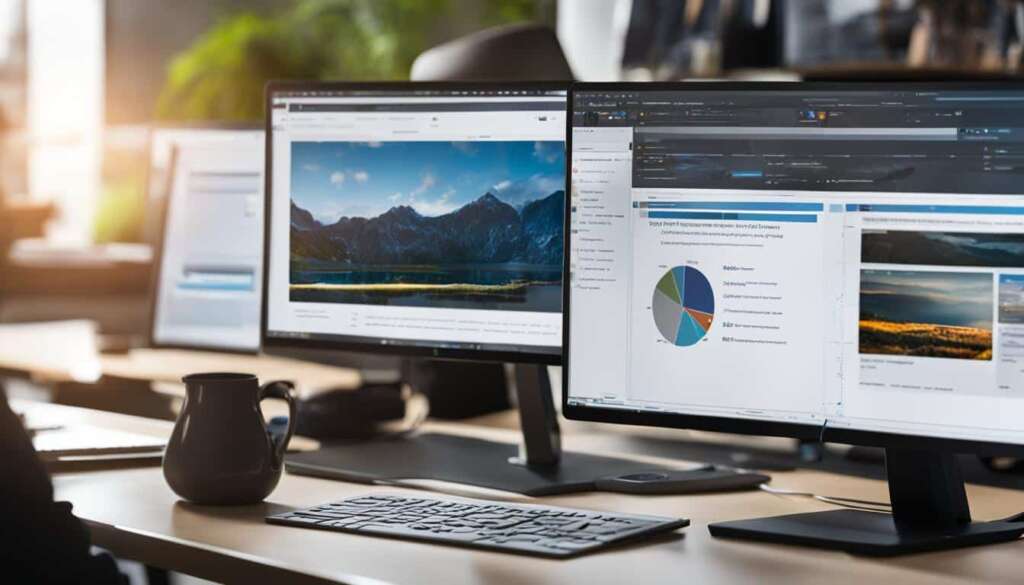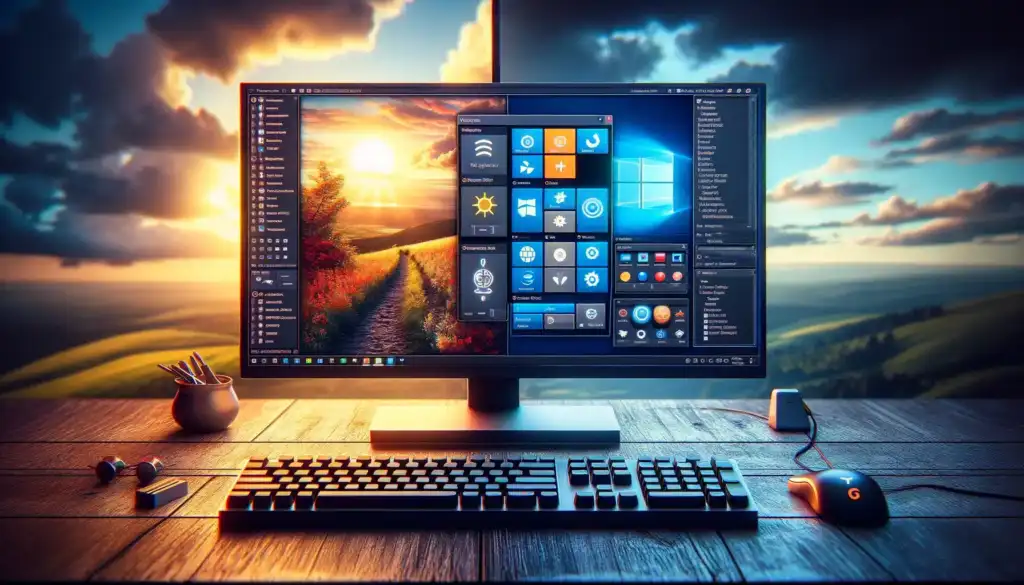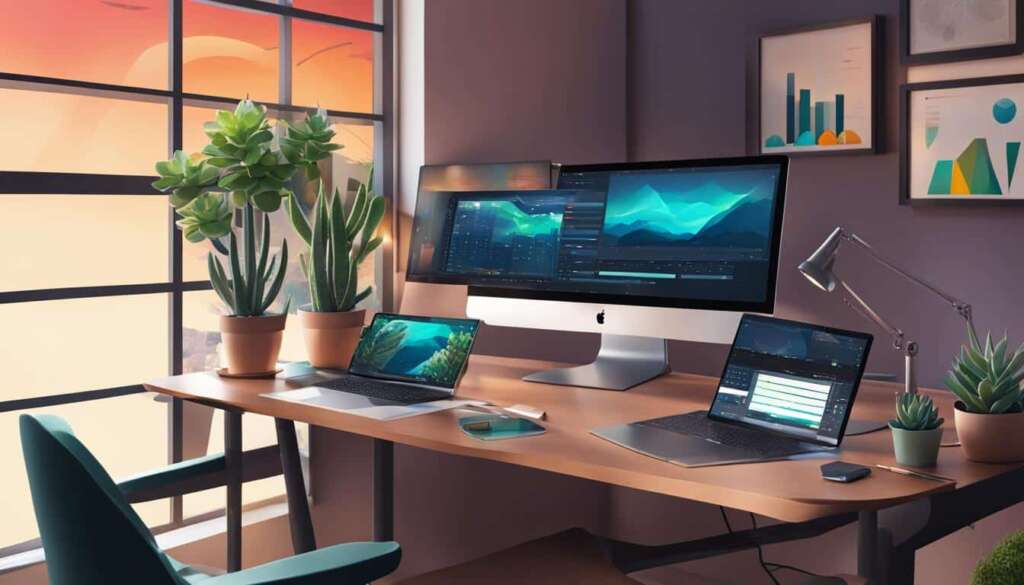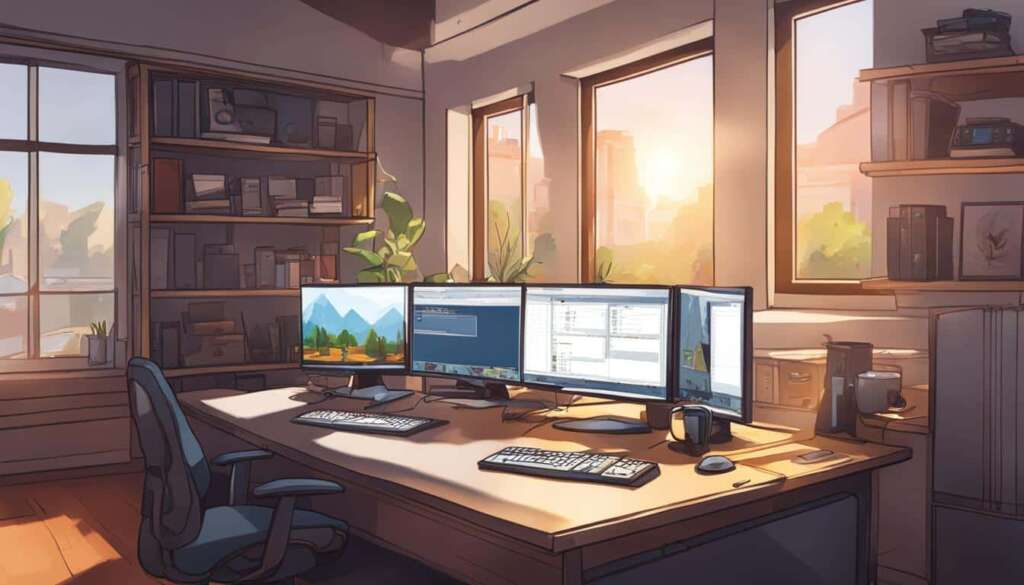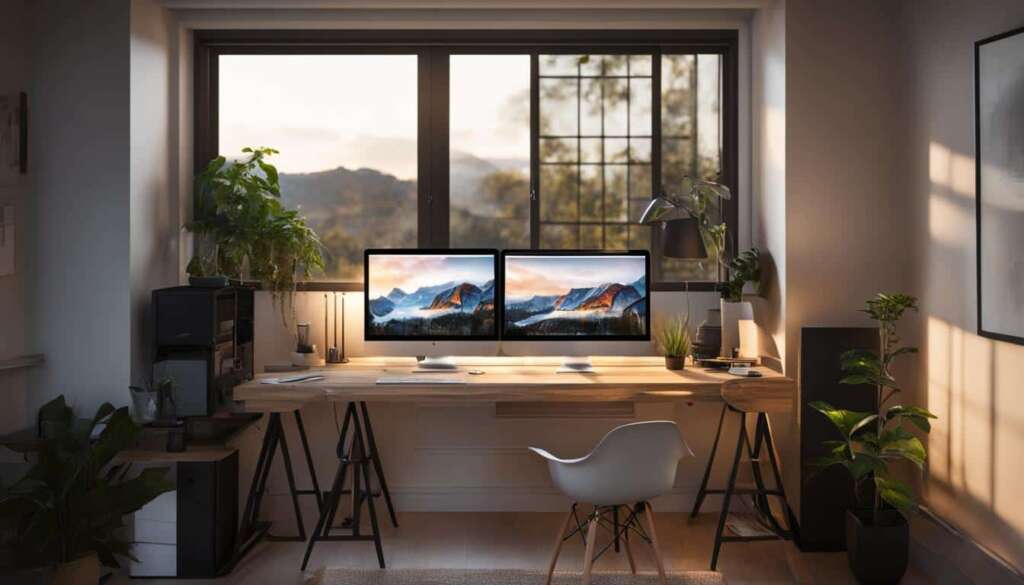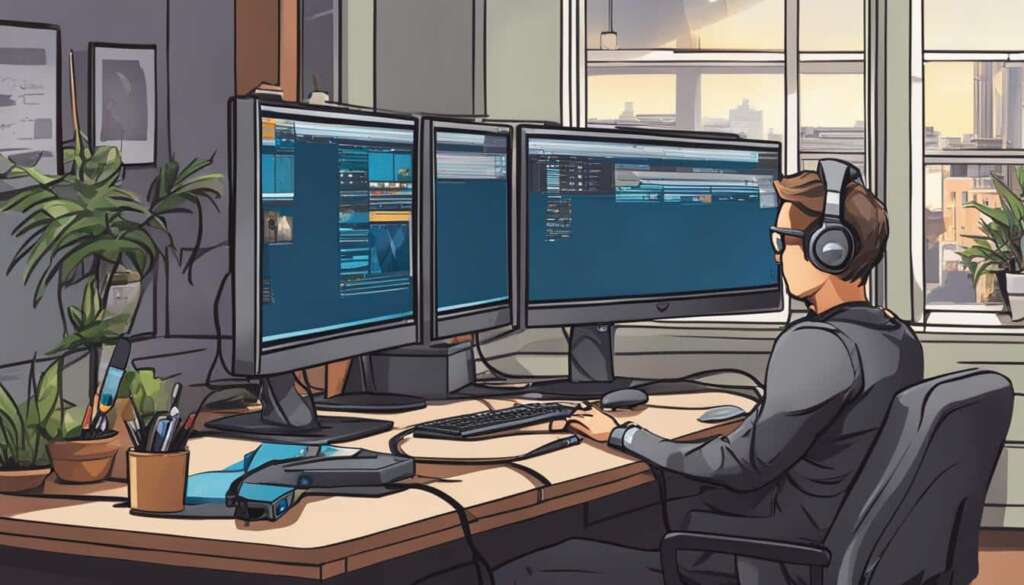Table of Contents
Welcome to our guide on how to connect two monitors to a laptop! Are you ready to elevate your productivity and take multitasking to the next level? With the right setup, you can seamlessly expand your vision and create a dynamic workspace that boosts your efficiency. In this article, we’ll walk you through the step-by-step process and provide valuable tips to make connecting dual monitors a breeze. So, let’s dive in and unlock the full potential of your laptop!
But first, let’s talk about the benefits of using dual monitors. By harnessing the power of two screens, you can increase productivity, reduce eye strain, and transform your laptop into a collaboration tool. Picture this – effortlessly switching between applications, running multiple tasks simultaneously, and seamlessly collaborating with colleagues. Sounds amazing, right? Trust us, once you experience the advantages of dual monitors, you’ll never want to go back.
Before we get into the nitty-gritty, let’s make sure you have everything you need to set up dual monitors. First and foremost, you’ll need a laptop with a video output port (HDMI, VGA, or DisplayPort) – an essential component for connecting to external monitors. Next, you’ll need two monitors with compatible video inputs, video cables to connect the monitors to your laptop, and a USB C hub if your laptop only has USB C ports. Now that you’ve gathered all the necessary equipment, let’s move on to the exciting part – the setup process!
Connecting two monitors to your laptop may seem like a daunting task, but fear not! We’ve got you covered with a detailed step-by-step guide. First, ensure your laptop is turned off, then plug in the first monitor using the appropriate cable. Next, turn on your laptop and patiently wait for it to recognize the first monitor. Once it’s detected, repeat the process for the second monitor. Lastly, adjust the display settings to your preference, and voila! You’re now fully immersed in the world of dual monitors.
Of course, like any technical endeavor, you may encounter some common issues along the way. Don’t worry, we’ve got troubleshooting solutions for you. If the displays aren’t detected, ensure both the laptop and monitors are turned on and connected properly. If you find yourself with mirrored displays instead of an extended desktop, don’t panic. Simply navigate to the display settings and make the necessary adjustments. And if you face the unfortunate situation of one monitor not working, try restarting your laptop or disconnecting and reconnecting the cables – this often does the trick.
If your laptop only features USB C ports, fret not! We have some excellent recommendations for USB C hubs that will save the day. Consider options like the Baseus Joystar 9 in 1 USB C Hub, known for its high-speed data transfer capabilities and USB C card reader, or the Baseus 12 in 1 Laptop USB C Hub, which offers a wide range of ports for connecting dual monitors. These handy gadgets will ensure a seamless connection between your laptop and monitors.
But wait, there’s more! If the USB C hub isn’t your preferred method, fear not, as we have other solutions too. You can explore options like docking stations, video splitters, graphics cards, or even repurposing a tablet as a second monitor. Remember, flexibility is key, and finding the right setup that fits your needs is essential.
In conclusion, connecting two monitors to a laptop is a game-changer when it comes to maximizing your productivity and workspace. Don’t limit yourself to a single screen – unleash your potential with dual monitors. Follow our step-by-step guide, troubleshoot along the way, and explore the various options available. Expand your vision, embrace the possibilities, and revolutionize the way you work with dual monitors!
Benefits of Using Dual Monitors
Using dual monitors can revolutionize your productivity and work experience. With two screens, you can increase efficiency, reduce eye strain, and collaborate seamlessly with your team. Let’s explore the key benefits of using dual monitors:
- Improved Productivity: Dual monitors provide a wide workspace that allows you to have multiple applications open simultaneously. You can easily switch between tasks without the need to constantly minimize and maximize windows. This seamless multitasking enables you to work more efficiently and complete tasks in less time.
- Reduced Eye Strain: Staring at a single screen for prolonged periods can lead to eye strain and fatigue. With dual monitors, you can distribute your workload across two screens, reducing the strain on your eyes. You can position the monitors ergonomically to minimize neck and back strain as well.
- Enhanced Collaboration: Dual monitors are an excellent collaboration tool, especially when working in a team setting. You can view and compare documents side by side, making it easier to collaborate on projects, review designs, or analyze data together. Dual monitors foster efficient communication and allow for seamless teamwork.
Dual monitors offer a transformative experience that can significantly boost your productivity, reduce eye strain, and facilitate collaboration. Take a look at the visual representation below to understand the advantages of dual monitors:
| Advantages of Dual Monitors | Benefits |
|---|---|
| Increased Productivity | Efficient multitasking and quicker task completion. |
| Reduced Eye Strain | Less strain on eyes and improved comfort during extended work sessions. |
| Enhanced Collaboration | Seamless teamwork and improved communication among team members. |
What You’ll Need to Connect Two Monitors to Your Laptop
Before setting up dual monitors, you’ll need a laptop with at least one video output port – HDMI, VGA, or DisplayPort. Ensure that your monitors have compatible video inputs. Additionally, you’ll require video cables to connect the monitors to your laptop. If your laptop only has USB C ports, a USB C hub will be necessary.
Having a laptop with video output is crucial as it serves as the main source for transmitting the display signal to the monitors. Monitors with compatible video inputs ensure seamless connectivity and optimal performance.
Video cables play a vital role in linking the laptop and monitors. The type of cable you use depends on the available ports on both your laptop and monitors. HDMI, VGA, and DisplayPort cables are commonly used for this purpose.
If your laptop is equipped with USB C ports instead of traditional video output ports, a USB C hub becomes essential. This hub acts as an adaptor by converting the USB C port into a video output port, allowing you to connect multiple monitors.
Let’s take a closer look at each of the components required to set up dual monitors:
Laptop with Video Output:
Your laptop needs to have at least one video output port – HDMI, VGA, or DisplayPort. These ports enable the transmission of visual data from the laptop to the monitors, allowing you to extend your display.
Monitors with Compatible Video Inputs:
Ensure that your monitors have video inputs compatible with the ports available on your laptop. This compatibility ensures a seamless connection, allowing the monitors to receive and display the video signal from the laptop.
Video Cables:
Video cables are vital for linking the laptop’s video output ports to the video inputs on the monitors. The type of cable you use depends on the available ports on both your laptop and monitors. Common options include HDMI, VGA, and DisplayPort cables.
USB C Hub (if applicable):
If your laptop only has USB C ports, a USB C hub becomes essential. This hub acts as an adaptor, converting the USB C port into a video output port, enabling you to connect your monitors.
By ensuring you have the necessary components – a laptop with video output, monitors with compatible video inputs, video cables, and a USB C hub if needed – you can successfully set up dual monitors and unlock the full potential of your workspace.
Step-by-Step Guide on How to Connect Two Monitors to a Laptop
Connecting two monitors to a laptop can significantly expand your workspace and enhance your productivity. By following these simple steps, you can easily set up a dual monitor configuration:
Step 1: Turn off your laptop
Before connecting the monitors, ensure that your laptop is turned off. This will prevent any potential connection or recognition issues.
Step 2: Plug in the first monitor
Take the appropriate cable (HDMI, VGA, or DisplayPort) and connect one end to the video output port on your laptop and the other end to the input port on the first monitor. Make sure the cable is securely connected.
Step 3: Turn on your laptop
Once the first monitor is plugged in, turn on your laptop. It will automatically detect the new monitor and start the recognition process. This may take a few moments.
Step 4: Wait for recognition
Allow your laptop some time to recognize the first monitor. You may see a notification or hear a sound when it is successfully recognized. Be patient during this process.
Step 5: Repeat for the second monitor
Once the first monitor is recognized, repeat the previous steps to connect the second monitor. Plug in the cable to the video output port on your laptop and the input port on the second monitor. Turn on your laptop and wait for the recognition process to complete.
Step 6: Adjust display settings
After both monitors are recognized and connected, you may need to adjust the display settings to your preference. Depending on your operating system, you can customize the display arrangement, resolution, and orientation.
With these simple steps, you can enjoy the benefits of a dual monitor setup, including increased productivity and a more efficient workflow. Now you can seamlessly multitask, work on multiple applications simultaneously, and expand your creative possibilities.
So, why wait? Create a powerful and versatile workstation by connecting two monitors to your laptop today!
| Step | Description |
|---|---|
| Step 1 | Turn off your laptop |
| Step 2 | Plug in the first monitor |
| Step 3 | Turn on your laptop |
| Step 4 | Wait for recognition |
| Step 5 | Repeat for the second monitor |
| Step 6 | Adjust display settings |
Note: The steps may vary slightly depending on the specific laptop model and operating system you are using. Refer to the user manual or documentation provided by the manufacturer for detailed instructions.
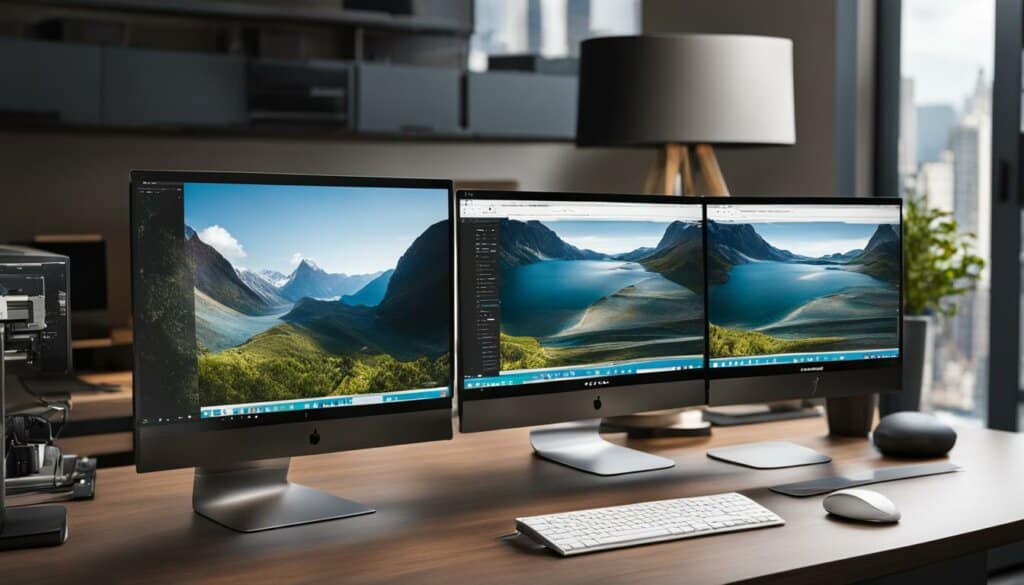
Troubleshooting Common Issues When Hooking Up Two Monitors to a Laptop
If you’re facing difficulties while connecting two monitors to your laptop, don’t panic! This section will guide you through common troubleshooting steps to overcome any obstacles. By following these recommendations, you’ll soon have both displays working seamlessly.
Displays not Detected
If your laptop isn’t detecting either of the connected monitors, there are a few things to check:
- Ensure that both your laptop and monitors are turned on.
- Confirm that the video cables are securely connected to both the laptop and the monitors.
- Try restarting your laptop to trigger the detection process again.
If your displays are still not detected after following these steps, try disconnecting and then reconnecting the cables to ensure a proper connection.
Displays Mirrored instead of Extended
If your displays are mirrored instead of extended, you’ll need to adjust the display settings:
- Right-click on your desktop and select “Display settings.”
- Scroll down to the “Multiple displays” section.
- Choose the “Extend these displays” option.
By following these steps, you’ll be able to use each monitor as an independent workspace, extending your vision and maximizing productivity.
One Display Not Working
If one of your displays is unresponsive or not working, try the following:
- Ensure that the monitor is turned on and connected properly.
- Check the cable connection between the laptop and the problematic monitor.
- Try connecting the faulty monitor to a different video output port on your laptop, if available.
If the issue persists, there may be a problem with the monitor itself, and you may need to consult the manufacturer or consider getting it repaired.
Remember, troubleshooting steps may vary depending on the specific laptop and monitors you’re using. Always refer to the user manuals or online support resources for more detailed instructions.
| Issue | Troubleshooting Steps |
|---|---|
| Displays not Detected | Ensure both laptop and monitors are on. Check cable connections. Restart the laptop. Disconnect and reconnect the cables. |
| Displays Mirrored instead of Extended | Right-click on desktop, select “Display settings.” Choose “Extend these displays” in the “Multiple displays” section. |
| One Display Not Working | Check if the monitor is on and connected properly. Verify cable connection. Try a different video output port if available. |
Best USB C Hubs for Connecting Dual Monitors
If your laptop only has USB C ports, you’ll need a USB C hub to connect dual monitors. Two recommended options are the Baseus Joystar 9 in 1 USB C Hub and the Baseus 12 in 1 Laptop USB C Hub.
The Baseus Joystar 9 in 1 USB C Hub offers high-speed data transfer and a USB C card reader, making it a versatile choice for connecting dual monitors. Its compact design allows for easy portability, perfect for remote work or travel. With multiple ports including HDMI, VGA, USB, and Ethernet, you can effortlessly connect your monitors while enjoying seamless multitasking.
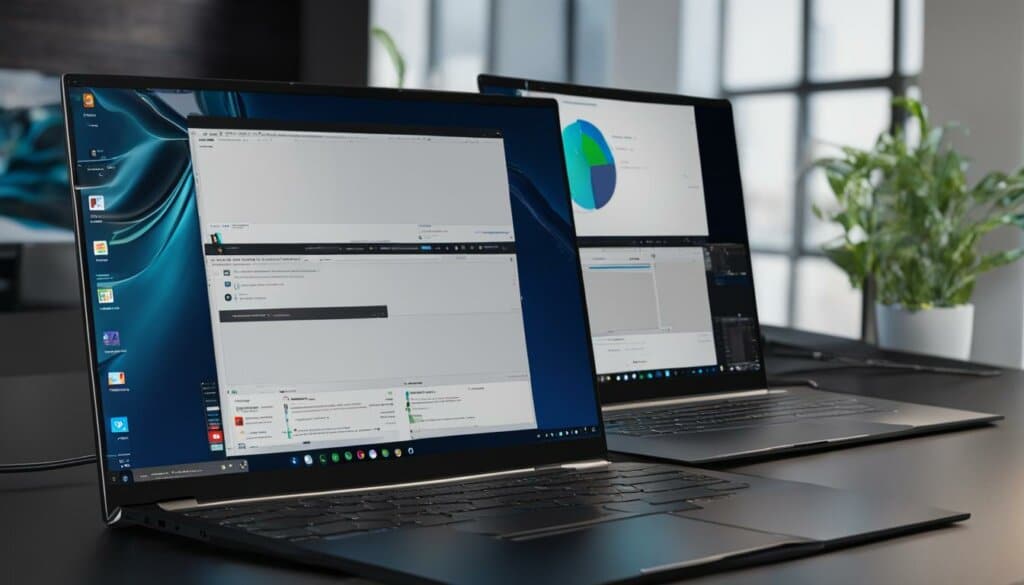
The Baseus 12 in 1 Laptop USB C Hub provides a wide range of ports, ensuring optimal connectivity for your dual monitors. With HDMI, VGA, USB, Ethernet, and SD card slots, you can easily connect your laptops to multiple monitors and other peripheral devices. Its sleek and durable design makes it a reliable choice for both home and office setups.
| Feature | Baseus Joystar 9 in 1 USB C Hub | Baseus 12 in 1 Laptop USB C Hub |
|---|---|---|
| Ports | USB C, HDMI, VGA, USB, Ethernet | USB C, HDMI, VGA, USB, Ethernet, SD Card Slots |
| Data Transfer | High-speed | High-speed |
| Compact Design | Yes | No |
| Card Reader | USB C | SD Card Slots |
Both the Baseus Joystar 9 in 1 and Baseus 12 in 1 USB C Hubs provide efficient solutions for connecting dual monitors to your laptop. Choose the one that best suits your needs and enjoy a seamless dual monitor experience, boosting your productivity and enhancing your workspace.
Other Ways to Connect Dual Monitors to Your Laptop
Aside from using a USB C hub, there are alternative methods to connect dual monitors to your laptop. These options provide flexibility and cater to different needs and preferences:
Docking Station
A docking station is a device that allows you to connect multiple peripherals to your laptop, including monitors. By connecting your laptop to a docking station, you can easily expand your display to dual monitors. Docking stations typically offer additional features such as extra USB ports, Ethernet connectivity, and charging capabilities.
Video Splitter
A video splitter is a hardware device that enables you to duplicate your laptop’s display onto multiple monitors. It takes a single video output from your laptop and splits it into multiple outputs, allowing you to connect dual monitors. This option is ideal if you want the same content displayed on both monitors.
Graphics Card
If you have a desktop computer with available expansion slots, you can install a graphics card that supports dual monitors. Graphics cards with multiple video outputs, such as HDMI, DisplayPort, or DVI, allow you to connect and extend your display to two monitors simultaneously. This option is not available for all laptops, as most laptops have integrated graphics that do not support dual monitors.
Repurposing Tablet as Second Monitor
If you have a tablet with a larger screen, you can repurpose it as a second monitor for your laptop. There are software applications available that allow you to use your tablet as an extended display. By connecting your tablet to your laptop via Wi-Fi or a USB cable, you can enjoy the benefits of dual monitors without the need for additional hardware.
While these alternatives provide options for setting up dual monitors, using a USB C hub is generally recommended due to its ease of use and versatility. A USB C hub eliminates the need for additional hardware and simplifies the setup process, making it an ideal choice for most users.
| Method | Pros | Cons |
|---|---|---|
| Docking Station | Easy connection | Requires additional hardware |
| Video Splitter | Same content on both monitors | Limited to duplicating display |
| Graphics Card | Allows for high-performance graphics | Not available for all laptops |
| Repurposing Tablet as Second Monitor | No additional hardware required | Dependent on software compatibility |
Conclusion
A dual monitor setup is a game-changer when it comes to maximizing productivity and creating an efficient workspace. By connecting two monitors to your laptop, you can expand your vision and seamlessly multitask, ultimately boosting your efficiency and output.
With the right equipment and setup, setting up dual monitors is a straightforward process that can yield significant benefits. The ability to work on multiple tasks simultaneously without constantly switching between applications can save you valuable time and streamline your workflow.
Not only does a dual monitor setup allow you to maximize productivity, but it also provides a larger workspace. The expanded screen real estate gives you more room to organize and view your work, reducing clutter and improving overall focus.
To embark on this journey towards a more efficient workspace, explore the wide range of options available for dual monitor setups. Whether you choose to invest in a USB C hub, a docking station, or utilize other innovative solutions, finding the setup that suits your needs will enhance your productivity and take your work to new heights.
FAQ
Can I connect two monitors to my laptop?
Yes, you can connect two monitors to your laptop. It requires a laptop with at least one video output port and two monitors with compatible video inputs.
What are the benefits of using dual monitors?
Using dual monitors increases productivity, allows for multitasking without switching applications, reduces eye strain and fatigue, and enhances collaboration in a team setting.
What do I need to connect two monitors to my laptop?
You will need a laptop with a video output port (such as HDMI, VGA, or DisplayPort), two monitors with compatible video inputs, video cables to connect the monitors to the laptop, and a USB C hub if your laptop only has USB C ports.
How do I connect two monitors to my laptop?
Start by turning off your laptop, plugging in the first monitor using the appropriate cable, turning on the laptop and waiting for it to recognize the first monitor, repeating the process for the second monitor, and finally adjusting the display settings to your preference.
What should I do if I encounter issues when connecting the monitors?
Common troubleshooting steps include ensuring that the laptop and monitors are turned on and connected properly, restarting the laptop, or disconnecting and reconnecting the cables. Additionally, adjusting the display settings can solve issues such as mirrored displays or one display not working.
What are the best USB C hubs for connecting dual monitors?
Two recommended options are the Baseus Joystar 9 in 1 USB C Hub, which offers high-speed data transfer and a USB C card reader, and the Baseus 12 in 1 Laptop USB C Hub, which provides a wide range of ports for connecting dual monitors.
Are there any other ways to connect dual monitors to a laptop?
Yes, other options include using a docking station, a video splitter, a graphics card, or repurposing a tablet as a second monitor. However, using a USB C hub is generally recommended for its ease of use and versatility.
What are the benefits of a dual monitor setup?
A dual monitor setup can greatly enhance productivity and create an efficient workspace. It allows for better multitasking, reduced eye strain, and improved collaboration.

